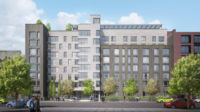A New Coalition Takes Aim at Emissions from Existing Buildings
At the U.S. Conference of Mayors, President Biden launches a partnership to reduce carbon emissions from the built environment

President Biden addresses the United States Conference of Mayors. Image Courtesy of the White House.
At the United States Conference of Mayors winter meeting, held earlier this month in Washington, D.C., President Biden announced a new collaboration with state and local governments to reduce carbon emissions from the built environment. Known as the Building Performance Standards Coalition, participating jurisdictions include the states of Washington and Colorado and 31 cities. Encompassing such major population centers as New York, Los Angeles, and Chicago, coalition members represent nearly 20 percent of the nation’s building stock, or about 15 billion square feet of floor space.
The program is intended to jump start development of building performance standards (BPS)—policies establishing specific performance levels that existing buildings must meet, explains Kim Cheslak, codes director at the New Buildings Institute, a nonprofit focused on decarbonizing the built environment. BPS programs are distinct from, but can complement codes, which apply to new construction or significant renovations.
Green building advocates often note that the vast majority—nearly 75 percent, by some estimates—of buildings that will exist in 2050 are already in operation. Consequently, reducing their greenhouse gas emissions will be imperative to solving the climate crisis. “We are particularly gratified to see that the coalition will pursue decarbonization through the retrofitting and upgrading of existing buildings,” said Rip Rapson, president and CEO of the Kresge Foundation, in a statement lauding the new initiative. “Although the United States has seen considerable progress in improving the energy performance of new buildings, existing buildings have proven a tougher nut to crack,” Rapson said.
A handful of state and local governments have already instituted BPS policies. Passed in April 2019, New York’s Local Law 97 was one of the first. It applies to structures 25,000 square feet and larger, setting statutory limits on the amount of carbon they can emit by building type. Other examples of jurisdictions with such programs are Boston; Chula Vista, California; Denver, as well as the State of Colorado; St. Louis; Washington, D.C.; and Washington State. All are members of the coalition.
The near-term goal is adoption of legislation or regulation in each of the member jurisdictions by Earth Day 2024. To accelerate BPS development, the Federal government is making a range of technical resources available to state and local governments to design and manage such policies, including energy performance analysis, data collection tools, and information on public and private sector financing options. The idea is to boost the annual rate of energy-related retrofits, which currently hovers at about two percent for schools and workplaces and less than one percent for homes, according to the Institute for Market Transformation, a non-profit whose mission is to increase demand for higher performing buildings.
Coalition members will be able to take advantage of $1.8 billion for policy implementation and building retrofits included in the bipartisan infrastructure bill signed into law last November. The Biden administration says participants will also benefit from a community-centered process in which place-based teams will co-create their local BPS programs. One challenge, says Cheslak, will be establishing common metrics. This will be especially important for owners with properties across several cities, she points out.
If the initiative accomplishes all its aims, it will do more than cut carbon. “Members of this groundbreaking coalition,” says Mark Chambers, senior director for building emissions and community resilience at the White House Council on Environmental Quality, “will help drive new jobs to make existing buildings across the country more efficient, affordable, healthier, and resilient and will deliver equitable benefits across their jurisdictions.”





